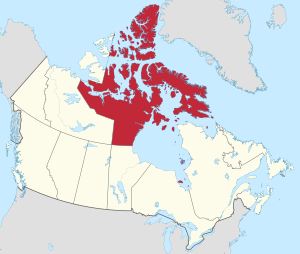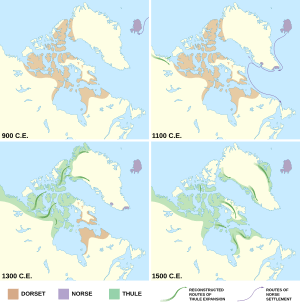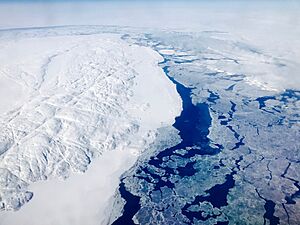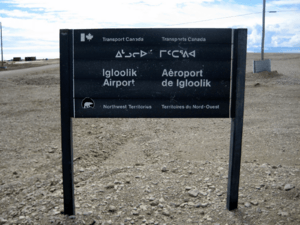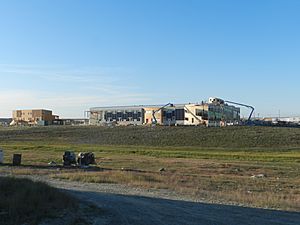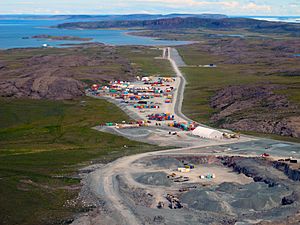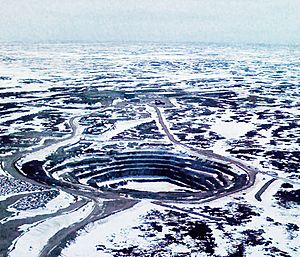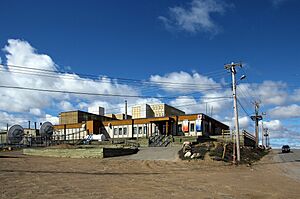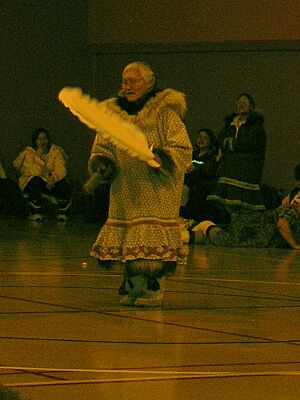Nunavut facts for kids
Quick facts for kids
Nunavut
Inuktitut syllabics ᓄᓇᕗᑦ
|
|||
|---|---|---|---|
|
|||
| Motto(s):
ᓄᓇᕗᑦ ᓴᙱᓂᕗᑦ (Nunavut Sannginivut)
"Our land, our strength" "Notre terre, notre force" |
|||
| Country | Canada | ||
| Confederation | April 1, 1999 (13th) | ||
| Capital | Iqaluit | ||
| Largest city | Iqaluit | ||
| Government | |||
| • Type | Parliamentary system, with consensus government | ||
| Area
(2021 – land, 2020 – water)
|
|||
| • Total | 1,997,923.78 km2 (771,402.68 sq mi) | ||
| • Land | 1,836,993.78 km2 (709,267.26 sq mi) | ||
| • Water | 160,930 km2 (62,140 sq mi) 8.1% | ||
| Area rank | Ranked 1st | ||
| 20% of Canada | |||
| Population
(2021)
|
|||
| • Total | 36,858 | ||
| • Estimate
(Q2 2024)
|
40,758 | ||
| • Rank | Ranked 13th | ||
| • Density | 0.02/km2 (0.05/sq mi) | ||
| Demonym(s) | Nunavummiut Nunavummiuq (sing.) |
||
| Official languages | Inuit (Inuktitut and Inuinnaqtun) English French |
||
| GDP | |||
| • Rank | 12th | ||
| • Total (2017) | C$2.846 billion | ||
| • Per capita | C$58,452 (6th) | ||
| HDI | |||
| • HDI (2021) | 0.930 – Very high (4th) | ||
| Time zones | UTC−07:00 (MST) | ||
| • Summer (DST) | UTC−06:00 (MDT) | ||
| UTC−06:00 (CST) | |||
| • Summer (DST) | UTC−05:00 (CDT) | ||
| Southampton Island (Coral Harbour) | UTC−05:00 (EST) | ||
| UTC−04:00 (Eastern Time) | |||
| • Summer (DST) | UTC−04:00 (EDT) | ||
| Postal abbr. |
NU
|
||
| Postal code prefix |
X0A, X0B, X0C
|
||
| ISO 3166 code | CA-NU | ||
| Flower | Purple saxifrage | ||
| Tree | n/a | ||
| Bird | Rock ptarmigan | ||
| Rankings include all provinces and territories | |||
Nunavut (which means "our land" in the Inuktitut language) is the largest and most northern territory in Canada. It officially became a separate territory from the Northwest Territories on April 1, 1999. This happened because of the Nunavut Act and the Nunavut Land Claims Agreement Act. These laws gave the Inuit people their own territory for self-government. The borders for Nunavut were decided in 1993. Creating Nunavut was the first big change to Canada's map in 50 years. The last big change was when Newfoundland joined Canada in 1949.
Nunavut covers a huge part of Northern Canada and most of the Arctic Archipelago. Its massive size makes it the fifth-largest country subdivision in the world. It is also North America's second-largest area after Greenland. The capital city is Iqaluit, which used to be called Frobisher Bay. It is located on Baffin Island in the east. Iqaluit was chosen as the capital in a vote in 1995. Other important communities include Rankin Inlet and Cambridge Bay.
Nunavut includes Ellesmere Island in the far north. It also has the eastern and southern parts of Victoria Island in the west. All islands in Hudson, James, and Ungava bays are part of Nunavut too. This includes the western part of Killiniq Island in the southeast and Akimiski Island far to the south. Nunavut is the only part of Canada not connected to the rest of North America by the Pan-American Highway.
Nunavut has the lowest population density of any major area in the world, not counting Antarctica. It has even fewer people per square kilometer than Denmark's Greenland. In 2021, Nunavut had 36,858 people. Most of these people are Inuit. The land area of Nunavut is almost as big as Mexico. It is about 1,836,993.78 square kilometers (709,267.31 sq mi). This means there are very few people living in such a large area.
Nunavut is also home to Alert, the world's most northern place where people live all the time. Eureka, a weather station on Ellesmere Island, has the coldest average yearly temperature of any Canadian weather station.
Contents
The land that is now Nunavut was first settled about 4,500 years ago. These first people were called the Pre-Dorset. They were a diverse group of Paleo-Eskimo people. They moved eastward from the Bering Strait area.
The Pre-Dorset culture was followed by the Dorset culture about 2,800 years ago. Experts believe that the Dorset culture grew out of the Pre-Dorset in some way.
Some old Norse stories talk about a place called Helluland. Many think this place was Nunavut's Baffin Island. It is debated whether the Dorset people ever met the Norse explorers.
The Thule people are the ancestors of today's Inuit. They started moving from Alaska in the 11th century. They moved into the Northwest Territories and Nunavut. By the year 1300, Thule settlements covered most of what is now Nunavut.
The arrival of the Thule people happened as the Dorset culture began to disappear. The Thule people completely replaced the Dorset people, both genetically and culturally, sometime after 1300.
First European Visitors
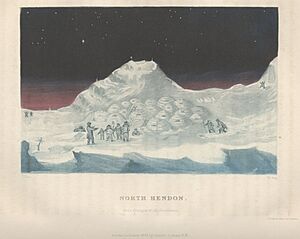
The first written record of this area is from 1576. It was written by an English explorer named Martin Frobisher. He was looking for the Northwest Passage. Frobisher thought he had found gold near what is now Frobisher Bay on Baffin Island. The "gold" turned out to be worthless. However, Frobisher was the first European to record meeting the Inuit people. Other explorers came in the 17th century looking for the Northwest Passage. These included Henry Hudson, William Baffin, and Robert Bylot.
In the 1950s, Cornwallis and Ellesmere Islands played a role in the Cold War. The Canadian government was worried about the area's important location. So, they moved Inuit families from Nunavik (northern Quebec) to Resolute and Grise Fiord. This was part of the High Arctic relocation. The families faced very difficult conditions and hunger. They were forced to stay there.
Forty years later, a special commission looked into this event. The government later paid money to the affected families and their descendants. On August 18, 2010, the Canadian government formally apologized for the relocation.
Talks about dividing the Northwest Territories began in the 1950s. This was to create a separate area for the Inuit. In 1976, during land claims talks, the idea of a new Inuit territory was discussed. On April 14, 1982, people across the Northwest Territories voted on this idea. Most residents voted yes. The Canadian government agreed seven months later.
The land claims agreement was finished in September 1992. Almost 85% of voters in Nunavut approved it in a special vote. On July 9, 1993, the Nunavut Land Claims Agreement Act and the Nunavut Act became law. The process to create Nunavut Territory was completed on April 1, 1999.
In 2020, Nunavut put strict rules on travel. This was to stop the spread of the COVID-19 pandemic. The government stopped almost all non-residents from entering. By October 2020, Nunavut was the only place in North America with no COVID-19 cases. On November 6, 2020, Nunavut confirmed its first case in Sanikiluaq.
Nunavut covers a huge area of land and water in Northern Canada. It has 1,836,993.78 square kilometers (709,267.31 sq mi) of land. It also has 160,930 square kilometers (62,137 sq mi) of water. The territory includes part of the mainland and most of the Arctic islands. All the islands in Hudson Bay, James Bay, and Ungava Bay are also part of Nunavut. This includes the Belcher Islands. All these areas were part of the Northwest Territories before Nunavut was created. This makes Nunavut the fifth-largest area in the world that is part of a country. If Nunavut were its own country, it would be the 15th largest by area.
Nunavut shares long land borders with the Northwest Territories. These borders are on the mainland and some Arctic islands. It also borders Manitoba to the south. Nunavut meets Saskatchewan at a single point in the southwest. It also has a short land border with Newfoundland and Labrador on Killiniq Island. The border with the Northwest Territories generally follows the tree line in Canada. Nunavut also shares water borders with Quebec, Ontario, and Manitoba. It shares an international border with Greenland, which is part of Denmark. This border is mostly water, but includes a small land border on Hans Island.
Nunavut's highest point is Barbeau Peak. It is 2,616 meters (8,583 ft) tall and is on Ellesmere Island. Nunavut has a very low population density. This means very few people live in a very large area. For example, Greenland has about the same area but almost twice as many people.
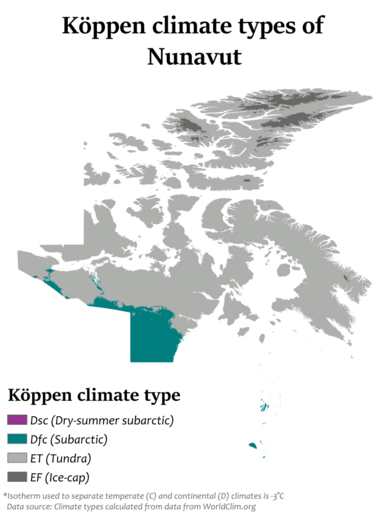
Most of Nunavut has a polar climate. This is because it is very far north. It also has less influence from the continent in summer compared to areas further west. In more southern areas of Nunavut, you can find very cold subarctic climates. This is because July temperatures are slightly milder than 10°C (50°F).
| City | July (°C) | July (°F) | January (°C) | January (°F) | ||||
|---|---|---|---|---|---|---|---|---|
| High | Low | High | Low | High | Low | High | Low | |
| Alert | 6 | 1 | 43 | 33 | −29 | −36 | −20 | −33 |
| Baker Lake | 17 | 6 | 63 | 43 | −28 | −35 | −18 | −31 |
| Cambridge Bay | 13 | 5 | 55 | 41 | −29 | −35 | −19 | −32 |
| Eureka | 9 | 3 | 49 | 37 | −33 | −40 | −27 | −40 |
| Iqaluit | 12 | 4 | 54 | 39 | −23 | −31 | −9 | −24 |
| Kugluktuk | 16 | 6 | 60 | 43 | −23 | −31 | −10 | −25 |
| Rankin Inlet | 15 | 6 | 59 | 43 | −27 | −34 | −17 | −30 |
| Climate data for Iqaluit (Iqaluit Airport) WMO ID: 71909; coordinates 63°45′N 68°33′W / 63.750°N 68.550°W; elevation: 33.5 m (110 ft); 1991–2020 normals, extremes 1946–present |
|||||||||||||
|---|---|---|---|---|---|---|---|---|---|---|---|---|---|
| Month | Jan | Feb | Mar | Apr | May | Jun | Jul | Aug | Sep | Oct | Nov | Dec | Year |
| Record high humidex | 3.3 | 5.2 | 4.3 | 6.8 | 13.3 | 21.7 | 27.8 | 27.6 | 18.8 | 8.6 | 4.8 | 3.4 | 27.8 |
| Record high °C (°F) | 3.9 (39.0) |
5.7 (42.3) |
4.2 (39.6) |
7.2 (45.0) |
13.3 (55.9) |
22.7 (72.9) |
26.8 (80.2) |
25.5 (77.9) |
18.4 (65.1) |
9.1 (48.4) |
5.6 (42.1) |
3.8 (38.8) |
26.8 (80.2) |
| Mean daily maximum °C (°F) | −22.0 (−7.6) |
−22.9 (−9.2) |
−17.6 (0.3) |
−8.9 (16.0) |
−0.3 (31.5) |
7.0 (44.6) |
12.0 (53.6) |
11.1 (52.0) |
5.6 (42.1) |
−0.5 (31.1) |
−7.5 (18.5) |
−14.7 (5.5) |
−4.9 (23.2) |
| Daily mean °C (°F) | −26.0 (−14.8) |
−27.0 (−16.6) |
−22.4 (−8.3) |
−13.5 (7.7) |
−3.2 (26.2) |
3.9 (39.0) |
8.1 (46.6) |
7.5 (45.5) |
2.9 (37.2) |
−3.2 (26.2) |
−11.1 (12.0) |
−18.9 (−2.0) |
−8.6 (16.5) |
| Mean daily minimum °C (°F) | −29.9 (−21.8) |
−31.0 (−23.8) |
−27.2 (−17.0) |
−18.1 (−0.6) |
−6.1 (21.0) |
0.7 (33.3) |
4.2 (39.6) |
3.8 (38.8) |
0.2 (32.4) |
−5.8 (21.6) |
−14.7 (5.5) |
−23.0 (−9.4) |
−12.2 (10.0) |
| Record low °C (°F) | −45.0 (−49.0) |
−45.6 (−50.1) |
−44.7 (−48.5) |
−34.2 (−29.6) |
−26.1 (−15.0) |
−10.2 (13.6) |
−2.8 (27.0) |
−2.5 (27.5) |
−12.8 (9.0) |
−27.1 (−16.8) |
−36.2 (−33.2) |
−43.4 (−46.1) |
−45.6 (−50.1) |
| Record low wind chill | −65.4 | −65.6 | −62.1 | −53.1 | −36.0 | −18.8 | −7.2 | −8.6 | −18.6 | −42.9 | −56.8 | −60.1 | −65.6 |
| Average precipitation mm (inches) | 16.3 (0.64) |
14.0 (0.55) |
21.4 (0.84) |
22.7 (0.89) |
21.0 (0.83) |
48.7 (1.92) |
39.8 (1.57) |
61.7 (2.43) |
50.8 (2.00) |
30.2 (1.19) |
18.5 (0.73) |
16.2 (0.64) |
361.2 (14.22) |
| Average rainfall mm (inches) | 0.4 (0.02) |
0.1 (0.00) |
0.0 (0.0) |
0.0 (0.0) |
3.3 (0.13) |
46.1 (1.81) |
44.4 (1.75) |
65.5 (2.58) |
43.9 (1.73) |
12.3 (0.48) |
0.7 (0.03) |
0.0 (0.0) |
216.6 (8.53) |
| Average snowfall cm (inches) | 19.4 (7.6) |
15.1 (5.9) |
20.6 (8.1) |
23.8 (9.4) |
23.0 (9.1) |
3.8 (1.5) |
0.0 (0.0) |
0.1 (0.0) |
8.5 (3.3) |
21.1 (8.3) |
25.9 (10.2) |
28.8 (11.3) |
190.0 (74.8) |
| Average precipitation days (≥ 0.2 mm) | 12.1 | 10.7 | 12.4 | 12.8 | 10.6 | 12.3 | 12.4 | 14.3 | 15.7 | 13.2 | 12.5 | 12.8 | 151.5 |
| Average rainy days (≥ 0.2 mm) | 0.06 | 0.06 | 0.06 | 0.06 | 1.7 | 10.7 | 13.1 | 14.8 | 13.2 | 3.8 | 0.24 | 0.0 | 57.7 |
| Average snowy days (≥ 0.2 cm) | 10.1 | 8.8 | 8.7 | 9.6 | 8.7 | 2.1 | 0.06 | 0.12 | 3.7 | 9.8 | 11.9 | 12.7 | 86.3 |
| Average relative humidity (%) (at 3pm) | 68.1 | 67.6 | 68.9 | 74.6 | 77.3 | 74.6 | 72.9 | 73.5 | 75.2 | 78.7 | 78.4 | 74.3 | 73.7 |
| Mean monthly sunshine hours | 32.4 | 94.0 | 172.2 | 216.5 | 180.5 | 200.2 | 236.8 | 156.8 | 87.9 | 51.4 | 35.6 | 12.6 | 1,476.8 |
| Percent possible sunshine | 18.5 | 39.0 | 47.4 | 48.2 | 31.9 | 32.5 | 39.3 | 31.0 | 22.4 | 16.8 | 17.7 | 8.9 | 29.5 |
| Average ultraviolet index | 0 | 0 | 1 | 2 | 4 | 4 | 4 | 3 | 2 | 1 | 0 | 0 | 2 |
| Source 1: Environment and Climate Change Canada (Bright Sunshine 1981–2010) | |||||||||||||
| Source 2: Weather Atlas | |||||||||||||
Visible minority and indigenous identity (2016): Inuit (84.7%) European Canadian (11.6%) Visible minority (2.5%) First Nations (0.5%) Métis (0.5%) Other Indigenous responses (0.2%)
Nunavut had a population of 36,858 people in the 2021 Canadian census. In 2021, most people, 30,865 (84.3%), identified as Inuit. There were also 180 First Nations people (0.5%), 120 Métis people (0.3%), and 230 people with other Indigenous backgrounds (0.6%). About 5,210 people (14.2%) were not Indigenous.
| Municipality | 2021 | 2016 | 2011 |
Change 2011–2021 |
Refs. |
|---|---|---|---|---|---|
| Iqaluit | 7,429 | 7,740 | 6,699 | 10.9% | |
| Rankin Inlet | 2,975 | 2,842 | 2,557 | 16.2% | |
| Arviat | 2,864 | 2,657 | 2,060 | 39.0% | |
| Baker Lake | 2,061 | 2,069 | 1,728 | 19.3% | |
| Igloolik | 2,049 | 1,744 | 1,538 | 33.2% | |
| Cambridge Bay | 1,760 | 1,766 | 1,452 | 21.2% | |
| Pond Inlet | 1,555 | 1,617 | 1,315 | 18.3% | |
| Pangnirtung | 1,504 | 1,481 | 1,325 | 13.5% | |
| Kinngait | 1,396 | 1,441 | 1,363 | 2.4% | |
| Kugluktuk | 1,382 | 1,491 | 1,302 | 6.1% |
Nunavut's population has been growing much faster than the rest of Canada for many years. This is mainly because birth rates are higher than the Canadian average. Between 2011 and 2016, Nunavut had the highest population growth rate of any Canadian province or territory, at 12.7%. Between 2016 and 2021, the population grew by 2.5%.
Languages Spoken
The official languages of Nunavut are the Inuit languages (Inuktitut and Inuinnaqtun), known as Inuktut, along with English and French.
In 2000, a report by Ian Martin said that English was a threat to Inuit languages. He said that school language policies were making this threat worse. He suggested a 20-year plan to make Nunavut a "fully functional bilingual society" in Inuktitut and English by 2020.
The plan included different ideas, such as:
- "Qulliq Model": For most communities, Inuktitut would be the main language taught in schools.
- "Inuinnaqtun Immersion Model": This would help bring back and strengthen Inuinnaqtun.
- "Mixed Population Model": For places like Iqaluit, where many people are not Inuit, different language needs would be met.
In the 2016 census, people were asked about their "mother tongue" (the first language they learned). The most common languages reported in Nunavut were:
| Rank | Language | Number of respondents | Percentage |
|---|---|---|---|
| 1 | Inuktitut | 22,070 | 63.1% |
| 2 | English | 11,020 | 31.5% |
| 3 | French | 595 | 1.7% |
| 4 | Inuinnaqtun | 495 | 1.4% |
At the time of the census, only English and French were counted as official languages. The numbers above are for people who reported only one mother tongue.
The 2016 census also showed that 2,045 people (5.8%) in Nunavut did not know either English or French. Of the 30,135 Inuit in Nunavut, 90.7% could speak either Inuktitut or Inuinnaqtun.
Beliefs and Religions
In the 2021 census, 73.5% of Nunavut's population identified as Christian. This was down from 86% in 2011. The number of people who reported no religion grew from 13% in 2011 to 24.9% in 2021. About 1.6% of the population reported other religious beliefs. These included Indigenous spirituality, Hinduism, Islam, Buddhism, and others.
Nunavut's economy is mainly driven by the Inuit and the Territorial Government. Other important parts of the economy include mining, oil, gas, and mineral exploration. Arts, crafts, hunting, fishing, whaling, and tourism are also important. Transportation, housing development, military activities, research, and education also contribute. Nunavut has one college, the Nunavut Arctic College. It also has several Arctic research stations. The new Canadian High Arctic Research Station (CHARS) is being planned for Cambridge Bay.
Iqaluit hosts the yearly Nunavut Mining Symposium every April. This is a big event that shows off the many economic activities happening in Nunavut.
Baffinland is the largest private employer in the territory. It has over 2,600 workers. In 2019, it was responsible for 23% of Nunavut's economic activity.
There are currently three main mines operating in Nunavut. Agnico-Eagle Mines Ltd has the Meadowbank Gold Mine. This is an open pit gold mine. It is expected to operate from 2010 to 2020 and employs 680 people.
The second mine is the Mary River Iron Ore mine. It is run by Baffinland Iron Mines. This mine is near Pond Inlet on North Baffin Island. They produce high-quality iron ore that can be shipped directly.
The newest mine to open is Doris North, also known as the Hope Bay Mine. It is operated by TMAC Resource Ltd. near Hope Bay Aerodrome. This new gold mine is the first of several possible mines in the Hope Bay greenstone belt.
Mining Projects
| Name | Company | In the region of | Material |
|---|---|---|---|
| Amaruq and Meliadine Gold Projects | Agnico-Eagle | Rankin Inlet | Gold |
| Back River Project | B2Gold | Bathurst Inlet | Gold |
| Izok Corridor Project | MMG Resources Inc. | Kugluktuk | Gold, Copper, Silver, Zinc |
| Hackett River | Glencore | Kugluktuk | Copper, Lead, Silver, Zinc |
| Chidliak | De Beers Canada | Iqaluit / Pangnirtung | Diamonds |
| Committee Bay, Three Bluffs Gold Project | Fury Gold Mines | Naujaat | Gold |
| Kiggavik | Areva Resources | Baker Lake | Uranium |
| Roche Bay | Advanced Exploration | Hall Beach | Iron Ore |
| Ulu, Lupin | Blue Star Gold, Elgin Mining Ltd. | Contwoyto Lake - connected to Yellowknife with an ice road | Gold |
| Storm Copper Property | Aston Bay Holdings | Taloyoak | Copper |
Past Mines
- Lupin Mine (1982–2005): This was a gold mine. Its current owner is Elgin Mining Ltd. It is near the Northwest Territories border, close to Contwoyto Lake.
- Polaris Mine (1982–2002): This mine produced lead and zinc. It was located on Little Cornwallis Island, near Resolute.
- Nanisivik Mine (1976–2002): This mine also produced lead and zinc. It was near Arctic Bay at Nanisivik.
- Rankin Nickel Mine (1957–1962): This mine produced nickel, copper, and platinum group metals.
- Jericho Diamond Mine (2006–2008): This mine produced diamonds. It was located 400 km (250 mi) northeast of Yellowknife. In 2012, it produced diamonds from existing piles but no new mining happened. It is now closed.
- Doris North Gold Mine: Newmont Mining did some underground work here. Newmont closed the mine and sold it to TMAC Resources in 2013. TMAC started commercial production in 2017.
Energy and the Environment

People in Nunavut mostly use diesel fuel to power generators and heat their homes. This fuel is brought from southern Canada by plane or boat. This is because there are very few roads or train links to the region. The government is trying to use more renewable energy sources. The community generally supports this effort.
This support comes from Nunavut feeling the effects of global warming. Former Nunavut Premier Eva Aariak said in 2011 that "Climate change is very much upon us." She added that it affects hunters and animals. The thinning of the ice and erosion from permafrost melting are also big worries. The Arctic region is warming about twice as fast as the global average.
- Northern Transportation Company Limited: This company helps with transportation. It is owned by Norterra, a company that was partly owned by the Inuvialuit of the Northwest Territories and the Inuit of Nunavut until 2014.
In the second half of 2018, people visited Nunavut 134,000 times. They spent $436 million. Two-thirds of these visits were by Nunavummiut (people living in Nunavut) traveling within the territory. The other visitors came from other parts of Canada or from other countries. They spent $219 million. Most visitors from outside Nunavut come from Ontario. The majority of these visitors are business travelers. In late 2018, only 14% of visitors were in Nunavut for fun. Fun activities for tourists in Nunavut include dog sledding, snowmobiling, cultural festivals, hiking, arctic wildlife safaris, and sea kayaking.
The Inuit Broadcasting Corporation is based in Nunavut. The Canadian Broadcasting Corporation (CBC) serves Nunavut with a radio and TV production center in Iqaluit. It also has an office in Rankin Inlet. Iqaluit has private radio stations CKIQ-FM and CKGC-FM. Both are owned by Northern Lights Entertainment Inc.
Newspapers
Nunavut has two main weekly newspapers. Nunatsiaq News is published by Nortext. Nunavut News/North is published by Northern News Services. This company also publishes Kivalliq News, which covers multiple territories.
Movies and Animation
The film company Isuma is based in Igloolik. It was started by Zacharias Kunuk and Norman Cohn in 1990. The company made the 1999 movie Atanarjuat: The Fast Runner. This film won the Caméra d'Or award at the 2001 Cannes Film Festival. It was the first feature film written, directed, and acted entirely in Inuktitut.
The National Film Board (NFB) has released "Animation from Cape Dorset" (1973). This collection includes the first animated films made by Inuit artists at the NFB. It features work by Solomonie Pootoogook, Timmun Alariaq, Mathew Joanasie, and Itee Pootoogook Pilaloosie. All of them took part in the Kinngait (formerly Cape Dorset) Film Animation Workshop on Baffin Island.
In November 2006, the National Film Board of Canada (NFB) and the Inuit Broadcasting Corporation started the Nunavut Animation Lab. This program offers animation training to artists in Iqaluit, Cape Dorset, and Pangnirtung. Films from this lab include Alethea Arnaquq-Baril's 2010 short film Lumaajuuq. This film won the Best Aboriginal Award at the Golden Sheaf Awards. It was also named Best Canadian Short Drama at the imagineNATIVE Film + Media Arts Festival.
In November 2011, the Government of Nunavut and the NFB announced a collection called Unikkausivut (Inuktitut: Sharing Our Stories). This collection makes over 100 NFB films by and about Inuit available. They are in Inuktitut, Inuinnaqtun, other Inuit languages, English, and French. The Government of Nunavut is giving Unikkausivut to every school in the territory.
The music of Nunavut includes Inuit throat singing and drum-led dancing. It also features country music, bluegrass, fiddling, square dancing, and the button accordion from Austria.
Circus and Arts
Artcirq is a group of Inuit circus performers based in Igloolik. The group has performed all over the world. This includes performing at the 2010 Olympic Winter Games in Vancouver, British Columbia.
Nunavut competes at the Arctic Winter Games. Iqaluit helped host the 2002 games along with Nuuk, Greenland.
Hockey Nunavut was started in 1999. It competes in the Maritime-Hockey North Junior C Championship.
Susan Aglukark is an Inuk singer and songwriter. She has released six albums and won several Juno Awards. She mixes Inuktitut and English languages with modern pop music. She uses her music to tell the stories of her people, the Inuit of the Arctic.
On May 3, 2008, the Kronos Quartet performed a new piece with Inuit throat singer Tanya Tagaq. The piece was called Nunavut and was based on an Inuit folk story. Tanya Tagaq is also known for working with Icelandic pop star Björk. Her 2018 novel Split Tooth was nominated for the Scotiabank Giller Prize.
Jordin John Kudluk Tootoo was born on February 2, 1983, in Churchill, Manitoba, Canada. He played in the National Hockey League (NHL) from 2003 to 2017. Although he was born in Manitoba, Tootoo grew up in Rankin Inlet. His father, Barney, taught him how to skate and play hockey there.
Hunter Tootoo is a Member of Parliament for Nunavut. He was elected to the Liberal government in 2015. He served as the Minister of Fisheries, Oceans, and the Canadian Coast Guard. He resigned from this position on May 31, 2016.
See also
 In Spanish: Nunavut para niños
In Spanish: Nunavut para niños




